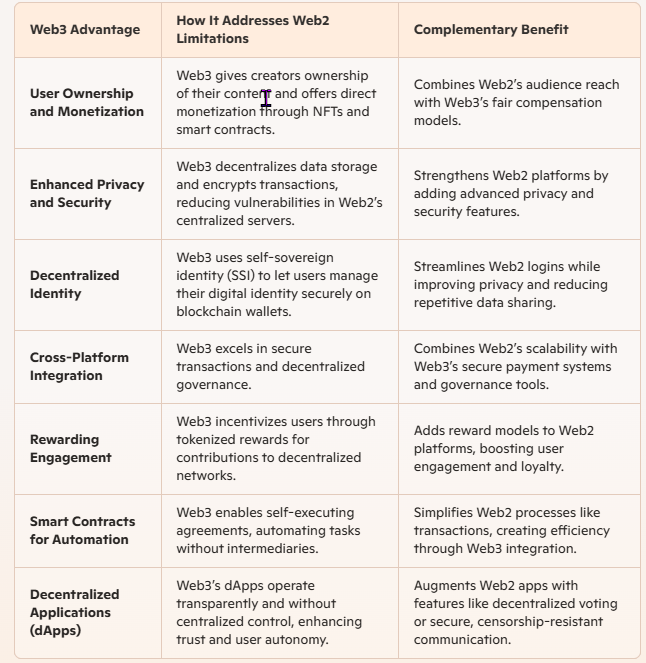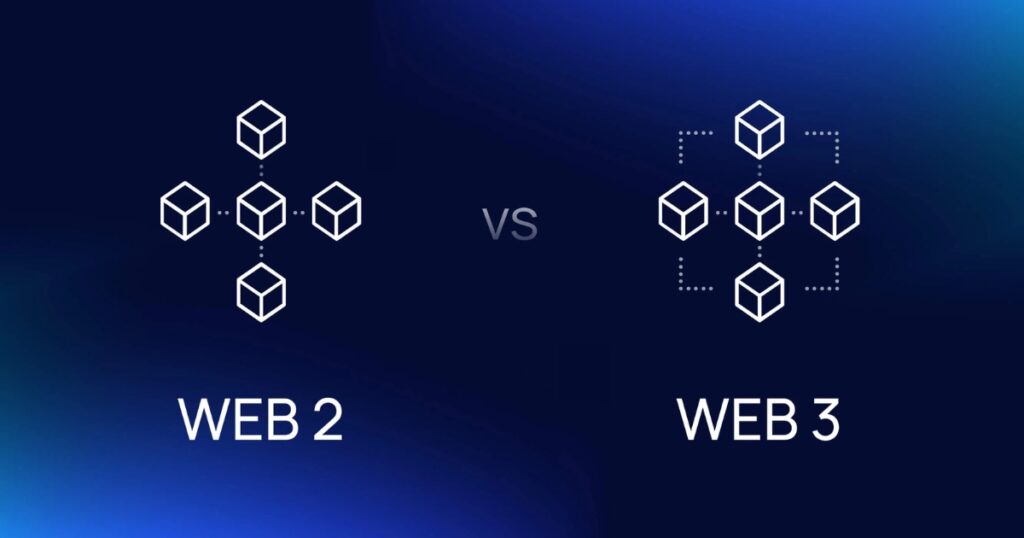Introduction: Two Generations of the Internet
The internet has gone through incredible changes over the years. Web2 transformed the way we interact online by giving us dynamic platforms for social connection, content sharing, and global communication. However, its centralized structure also came with drawbacks like privacy concerns, data exploitation, and limited user control.
Now, Web3 is stepping into the spotlight, introducing decentralization, user ownership, and blockchain-based innovation. Some believe Web3 will entirely replace Web2, ushering in a fully decentralized digital era. But is Web3 meant to take over completely? The answer is no—Web3 is designed to enhance and complement Web2 rather than replace it entirely.
This blog will explore why Web3 is not a competitor to Web2 but rather a powerful addition that addresses its weaknesses. Together, these two technologies can pave the way for a better internet experience.
What Is Web2?
Web2 represents the second generation of the internet, characterized by interactivity and user-driven content. It introduced features like social media, e-commerce, and real-time communication, revolutionizing how people connect online. Platforms like Facebook, Amazon, and YouTube are staples of Web2, allowing users to share their thoughts, shop globally, and upload videos in seconds.
However, the centralized nature of Web2 has raised concerns:
- Centralized Ownership: Large corporations control platforms and user data.
- Data Exploitation: Companies profit from selling user data to advertisers.
- Privacy Risks: Central servers are vulnerable to breaches and surveillance.
What Is Web3?
Web3 is the next evolution of the internet, driven by blockchain technology and decentralization. Instead of relying on central authorities, Web3 gives users control over their data and assets. Its defining features include:
- Decentralization: Data is stored across nodes rather than centralized servers.
- User Ownership: Individuals manage their own digital identities and assets.
- Enhanced Privacy: Transactions and interactions occur without exposing sensitive information.
- Smart Contracts: Self-executing agreements that automate processes securely.
- Tokenization: Rewards and incentives for user participation in decentralized networks.
Web3 is already being used for applications like decentralized finance (DeFi), NFTs, and decentralized applications (dApps), making it a key driver of the internet’s future.
The Myth: Web3 Will Replace Web2
Many assume Web3 will completely replace Web2, leaving centralized platforms behind. This belief stems from Web3’s promise of decentralization and privacy. While it’s true that Web3 addresses many weaknesses of Web2, the idea of replacement oversimplifies the potential of both systems.
Here’s why Web3 isn’t positioned to replace Web2:
- Scalability Challenges: Web3 technology is still evolving and doesn’t yet offer the scalability required for global adoption.
- Ease of Use: Web2 platforms are user-friendly and deeply embedded in daily life.
- Complementary Strengths: Web3 excels in decentralization, while Web2 is more efficient for mass communication.
Web2 and Web3 aren’t adversaries—they’re partners working together to create a more robust internet.
Reality: Web3 Complements Web2
Rather than replacing Web2, Web3 adds new layers of functionality and control. Here’s how the two systems complement each other:
1. User Ownership and Monetization
Web2 platforms rely on user-generated content for profit but rarely compensate creators fairly. Web3 flips this model by allowing creators to own their content and monetize it directly.
Example:
- In Web2, an artist shares their work on Instagram, but Instagram controls the platform and monetization.
- In Web3, the same artist can mint their work as an NFT, selling it directly to buyers while retaining ownership.
How They Complement: Web2 provides visibility, while Web3 ensures creators are compensated fairly.
2. Enhanced Privacy and Security
Web2 stores user data on centralized servers, which are vulnerable to hacks and misuse. Web3’s decentralized architecture offers greater security and privacy, storing data across nodes and encrypting transactions.
Example: Web2 social media platforms track user activity for advertising, while Web3 social networks use blockchain to protect data from unauthorized access.
How They Complement: Web3’s privacy solutions can be integrated into Web2 platforms for enhanced security.
3. Decentralized Identity Management
In Web2, users create separate accounts for each platform, exposing their data repeatedly. Web3 introduces self-sovereign identity (SSI), allowing users to control their identity through blockchain wallets.
Example: Instead of entering personal details on multiple Web2 apps, users can log in securely using a Web3 wallet.
How They Complement: Web2 platforms can adopt SSI to improve data protection.
4. Cross-Platform Integration
Web2 is efficient for widespread communication, while Web3 excels in secure transactions and decentralized governance. Together, they create seamless experiences for users.
Example: A Web2 e-commerce site could integrate Web3 payment systems for secure cryptocurrency transactions.
How They Complement: Combining Web2’s scalability with Web3’s security enriches the user experience.
5. Rewarding Engagement
Web2 platforms profit from user engagement but rarely share benefits. Web3 incentivizes participation through token rewards and decentralized governance.
Example:
- In Web2, users post content without direct rewards.
- In Web3, users earn tokens for contributing to decentralized networks.
How They Complement: Web2 can adopt Web3’s tokenization models for better user engagement.
6. Smart Contracts for Automation
Web2 processes often require intermediaries, while Web3 uses smart contracts to automate tasks securely. For example, a Web3 smart contract can automate payments for services without involving banks.
Example: Web2 businesses could integrate Web3 smart contracts to streamline transactions.
How They Complement: Web3’s automation tools enhance Web2’s operational efficiency.
7. Decentralized Applications (dApps)
Web2 apps operate on centralized servers, leading to concerns about data ownership and censorship. Web3 dApps offer transparency and user control without central ownership.
Example: Web2 platforms can incorporate dApps for features like decentralized voting or secure messaging.
How They Complement: Web2 apps can use dApps for specific functionalities while maintaining their broader operations.
Web 3 Partnerships
Web3 isn’t here to compete with Web2 but to act as its ideal partner by addressing its limitations and unlocking new possibilities through blockchain technology, AI advancements, and stronger security measures. While Web2 excels in scalability, user-friendly platforms, and global connectivity, Web3 steps in to fill the gaps with decentralization, enhanced privacy, and user ownership. With blockchain as its foundation, Web3 ensures data integrity through immutability, protects sensitive information with advanced encryption, and eliminates single points of failure by decentralizing storage across nodes. The integration of AI into Web3 takes this even further, enabling intelligent decision-making and automation through smart contracts and decentralized algorithms. By merging Web2’s familiar frameworks with Web3’s innovative solutions, the two systems create a more secure, equitable, and user-controlled internet, proving they are stronger together than apart.

The Future of Web2 and Web3
The internet’s future lies in the collaboration between Web2 and Web3. By combining Web2’s scalability and user-friendly interfaces with Web3’s decentralization and security, we can create a more inclusive digital ecosystem.
Potential developments include:
- Social media platforms integrating Web3 wallets for digital asset management.
- Streaming services offering tokenized rewards for user engagement.
- E-commerce adopting blockchain for supply chain transparency.
Instead of competing, Web2 and Web3 can work together to enhance the internet for everyone.
Conclusion: Myth or Reality?
The idea that Web3 will replace Web2 is a myth. In reality, Web3 complements Web2, adding new layers of functionality, privacy, and user control. While Web2 remains essential for its scalability and ease of use, Web3 introduces innovative tools to address its limitations.
By working together, Web2 and Web3 create a balanced internet that empowers individuals while retaining efficiency. As the two ecosystems evolve, their integration will unlock exciting opportunities for collaboration and growth.

